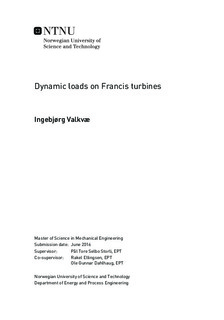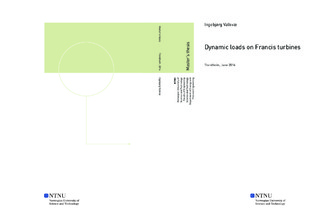| dc.description.abstract | New installations of unregulated power to the electrical grid have led to more fluctuations in the grid frequency. Hydropower plants with large reservoirs can provide services to balance the frequency by increasing or reducing production in accordance to what is needed. However, such balancing services are putting stress on the turbines by exposing them to dynamic loads. In the recent years, several high head Francis turbines have been taken out of operation due to cracks in the runner. It is thought to be because the turbines are not designed with sufficient measures to handle all the types of dynamic loads appearing during variations in operation. Analysis of stresses caused by fluid-structure interaction (FSI) is therefore of increasing interest in the hydropower industry.
In this thesis, pressure and strain measurements have been performed on the Francis test rig in the Waterpower Laboratory at NTNU. The results were further used as validation of a FSI analysis conducted on the same turbine model in the software program ANSYS. The rotational speed of the runner was decreased by 60 rpm over a time period of 2 seconds to illustrate how an estimated change in grid frequency impact stresses in the turbine.
The results from the FSI simulation showed high stresses both on the leading and trailing edge of the runner blades, where the maximum stress was found on the trailing edge tip towards the shroud. A decrease in runner speed resulted in a decrease in material stresses. At the end time, the maximum equivalent stress has a magnitude of 5 MPa, which is way below the yielding limit for the material. Validation of the CFD simulation showed sufficient correlation between the measured and simulated pressures. However, it was difficult to achieve a comparison of strain results with the strain gage, and the FSI results should therefore be further validated before they can be used as background for more research. | |

